Living on the Edge: Softening the Lines Between Hardscapes and Landscapes
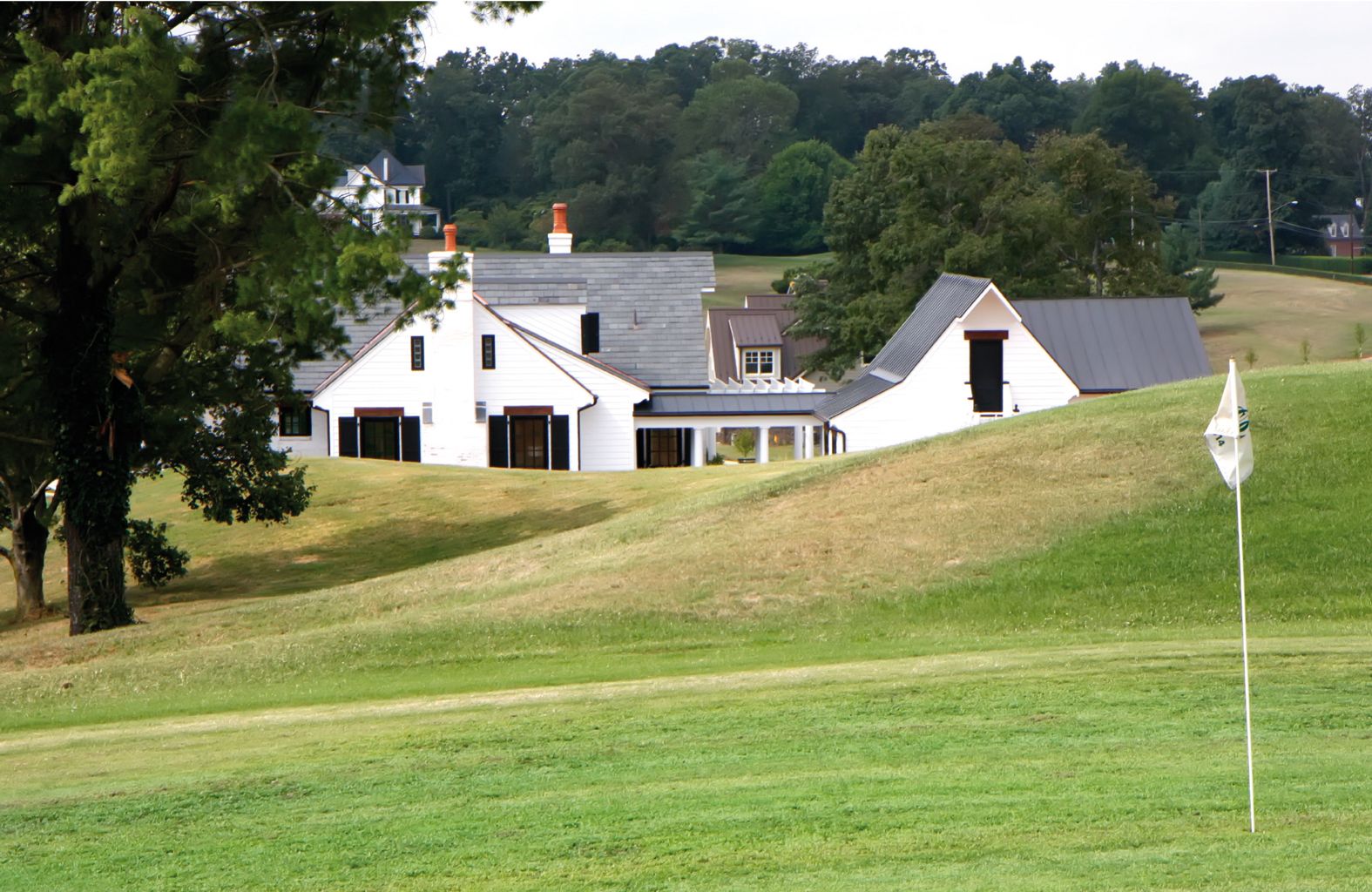
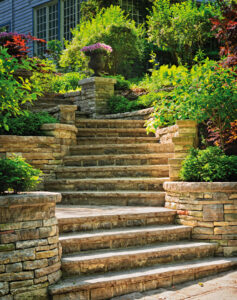 As our yards are returning to their warm-weather glory with the arrival of spring, many of us will be itching to enjoy the outdoor spaces we’ve missed all winter. In recent years, the trend of embracing gardens, patios, and lawns as extensions of the home has expanded how people think of and use their yards. With homeowners looking for more ways to develop their yards, features such as decks, fire pits, pools and patios have become increasingly common. Though these elements (generally referred to as hardscapes) serve great purposes, they can create visual discord with their hard lines and rigid looks if they are not balanced and buffered with proper landscaping.
As our yards are returning to their warm-weather glory with the arrival of spring, many of us will be itching to enjoy the outdoor spaces we’ve missed all winter. In recent years, the trend of embracing gardens, patios, and lawns as extensions of the home has expanded how people think of and use their yards. With homeowners looking for more ways to develop their yards, features such as decks, fire pits, pools and patios have become increasingly common. Though these elements (generally referred to as hardscapes) serve great purposes, they can create visual discord with their hard lines and rigid looks if they are not balanced and buffered with proper landscaping.
Hardscapes and landscaping are often addressed as separate projects. But by treating these two elements as separate entities, you could be limiting your property’s overall aesthetic potential. If you were instead to take a step back and imagine your yard, driveway, garage, porch, patio, deck, sidewalks, pool and everything that surrounds them as an extension of your home, the results could be surprising. Literally softening the edges of your hardscapes by utilizing good landscaping techniques can blur the lines between the two, creating a visual flow and elevating your property to resort-like status.
The Lay of the Land
As with any project, it is important to plan ahead and have a good understanding of the way your structures and yard work with each other and what you hope to accomplish. Maybe your home sits on the side of a hill and you are having problems with erosion control. Perhaps you have rows of shrubbery around your front porch, and all that’s needed is proper pruning to smooth over the rough edges. Or it could be that your driveway appears long and boring with all the visual interest of a runway. Embrace the natural flow of your land and imagine how you could work out some of the blockier corners or bare areas.
All Hands on Deck
Some of the more common hardscapes are patios and even low-lying decks. When planning for landscaping additions here, start by going out and sitting on your patio or deck and take note of where your gaze is naturally drawn. This should be the focal point of any landscaping work. Keep in mind that your entire yard will be viewed as one large presentation that does not end with the perimeter of your deck or patio structure. For this reason, it is important to make sure one area flows into the next. This might mean planting colorful border trees and shrubberies all around the exterior of your yard as sort of a backdrop for your presentation.
“Adding depth to the beds around a hardscape project allows for large shrubs or small trees like crepe myrtles or Japanese maples to be incorporated,” says Jason Childress, landscape designer for Varsity Landscaping and Grounds in Roanoke. “These vertical elements add visual interest and break up the often flat surfaces,” Childress continues. Evergreens such as juniper and cypress are also great picks that will provide year-round greenery, and are excellent selections for those looking for privacy borders.
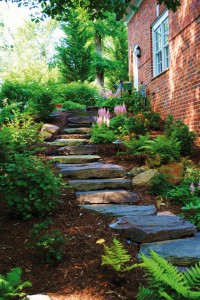
With the foundational vegetation in place, you can begin layering smaller plants in the foreground and around your hardscapes to relax the look of their rigid lines with lighter, airy foliage. Many herbs will help you achieve a delicate look around your ground-level deck or patio without a lot of maintenance. Look for dill, thyme, Russian sage, lavender and rosemary to supplement soft texture (not to mention the added aromatic and culinary benefits!). Another trick to creating a relaxed atmosphere is to avoid a precise pattern in your plant groupings.
Intermingling your shorter flowering plants and grasses can give your bed a more natural look, and allowing the plants to fill in on their own will mean less weeding down the road. Consider the layout of your particular hardscape and what areas might especially benefit from landscaping. Turn the severe corners where a sidewalk meets a driveway into an eye-pleasing flower grouping with a fluid, curved border. Buffer elevated features, such as stair railing or a trellis, with taller plants that won’t be dwarfed next to them, or consider climbing plants, such as clematis, to add interest above ground level.
For elevated decks, when the structure is at least 4 or 5 feet off the ground, there are a few additional factors to consider. From your perch, you’ll be gazing at a downward angle on your yard and plantings. Again, establish taller plants first and then work your way down to medium and low-lying choices. Consider shrubs that will grow to be bushy and tall enough to fill in the gaping space between the deck and the ground, such as arborvitae for an evergreen choice, or hydrangea and rhododendron to provide a bright pop of color. Don’t hesitate to bring flora up onto the deck as well. Container gardening is an easy and low-maintenance way to break up the wood-on-wood monotony of a large deck. Group containers of various heights together, or create a terrace effect by placing pots of trailing plants like sweet potato vine, verbena, begonia and nasturtium up a flight of stairs. Under the deck itself, the most practical choice may be stone mulch (with weed cloth beneath to keep undesirable “volunteers” at bay) since the lack of sunlight prevents hearty grass growth. Available in many colors and textures, there is certainly a stone mulch variety available to complement your hardscape. Stone mulch is also very effective at slowing erosion, making it a great choice to incorporate into landscaping for aesthetic and practical reasons.
Slippery Slopes
Our area is known for its hills, and in some spots it would appear as if every single home is built on an angle. Many homeowners struggle with slope retention and erosion. Fortunately there are elegant ways to deal with these hard-to-landscape problem areas, and the results can be beautiful.
Before proceeding with landscaping slopes, you must consider the soil type and how steep a slope you are dealing with. Ground covers are great choices for hillsides as their root systems will help provide a sturdy “grip” to the soil. Furthermore, many ground cover species require little maintenance and provide a great wispy look that often stays year-round. Look to things like junipers, creeping thyme and mosses. To provide height and color, gardenia, nandina, loropetalum, liriope and rhododendron will be successful on slopes.
Terracing walls and creating distinctive walkways to deal with slope provide opportunity for some unique landscaping, which would not be possible on a flat lot. Forming terraces, whort for your slope. A common choice for these walls is to apply stucco over a concrete, brick or block base. In addition, stacking smaller walls into tiers or creating a serpentine wall adds visual interest.
“Planting shrubs, perennials and annuals above a wall that will drape over will serve to soften and can add color,” says Randy Brannan of Roanoke Landscapes. “Strategic planting both above and at the base of the wall will add interest and make the wall seem an integral part of the landscape rather than simply a utility item.”
Combining outdoor stairways with your terraced walls is also a great strategy. You may even decide to include some stepables (plants that tolerate foot traffic) between your stairways and flagstone or paver walkways. Dwarf mondo grass, creeping Jenny, Irish moss and many varieties of mint are all great selections.
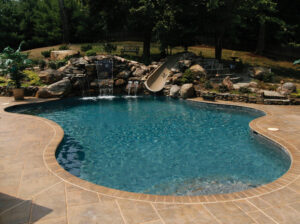 Pools
Pools
If you’re lucky enough to have a pool, it’s important to address how it fits with the landscaping. A pool area with great landscaping can become a gorgeous,
spa-like destination in your own backyard. For the most part, pools can be treated much like other hardscape structures, although there are a couple of things to consider.
Brannan suggests reaching out to a landscape professional before construction so that options other than concrete can be explored. “Interlocking concrete pavers offer much more in the way of color, designs, durability and flexibility than does poured concrete.” This is also the ideal time to incorporate planters, fire features, and even kitchen elements. “Vertical surfaces give that ‘outdoor room’ feeling,” adds Brannan.
Childress of Varsity Landscaping and Grounds says that “plant choices should driven by the season, so focus on summer and early fall blooming plants like crepe myrtles, knockout roses and ornamental grasses as well as summer perennials like black-eyed susan, coneflowers and shasta daisies to provide maximum impact during the time your pool is being used the most.” Also consider adding tall ornamental grasses, such as pampas or pink muhly grass, which may look fluffy but are actually very hearty. They will give your pool the atmosphere of an oasis.
Non-Plant Elements
Good landscaping takes all of these factors into consideration; great landscaping goes far beyond selecting the right planters and mulch, however. Consider using non-plant elements to elevate your yard to the next level and give it a resort-like status by adding an unexpected statement piece.
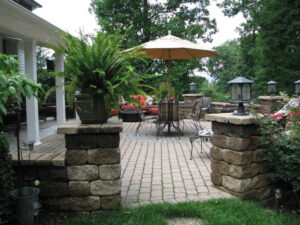 If you find yourself craving that “something extra” in your yard but aren’t ready to undertake a big project, look to features that are ready-to-install that you can simply landscape around. Effects such as a small fountain, a grouping of boulders, a garden bench, or a pair of large urns overflowing with flowers can add a lot of character with minimal effort. Take the opportunity to select a piece that reflects your desired overall atmosphere for your yard, whether it’s an oversized lantern for a Zen look, a masculine log bench for rustic elegance, or a simple yet contemporary water feature for a modern flair. Use mulch or groundcover around the base, then work your way into low-lying plants like phlox and lantana, then on to slightly taller choices such as coleus or hosta to layer in bright greens, working upwards with taller plants like hollyhock and dahlia. Use the plants you already have incorporated into other landscaping to frame this centerpiece and give a dramatic yet unified effect. Do keep in mind that when it comes to statuary and other non-plant elements, too much can give your yard a cluttered appearance. Don’t overdo it!
If you find yourself craving that “something extra” in your yard but aren’t ready to undertake a big project, look to features that are ready-to-install that you can simply landscape around. Effects such as a small fountain, a grouping of boulders, a garden bench, or a pair of large urns overflowing with flowers can add a lot of character with minimal effort. Take the opportunity to select a piece that reflects your desired overall atmosphere for your yard, whether it’s an oversized lantern for a Zen look, a masculine log bench for rustic elegance, or a simple yet contemporary water feature for a modern flair. Use mulch or groundcover around the base, then work your way into low-lying plants like phlox and lantana, then on to slightly taller choices such as coleus or hosta to layer in bright greens, working upwards with taller plants like hollyhock and dahlia. Use the plants you already have incorporated into other landscaping to frame this centerpiece and give a dramatic yet unified effect. Do keep in mind that when it comes to statuary and other non-plant elements, too much can give your yard a cluttered appearance. Don’t overdo it!
Another element that works wonders at softening a hardscape project is landscape lighting. “It is important to be creative with your lighting design and avoid the ‘runway effect’ of a straight line of path lights,” says Childress. “Uplighting trees not only provides visual interest on the plant and unique shadows, it also reflects back down to help light your patio or sidewalk.”
Putting it all Together
The sky’s the limit when it comes to landscaping around your home. The best-looking homes and yards combine all types of landscaping styles and strategies to fit the natural layout of their spaces. And they also reflect what you really want to get out of your space—whether that’s entertaining by the barbeque on the patio, spending a day of fun in the sun in the pool, or simply spending a quiet afternoon taking in the beauty of your garden. Keep these principles in mind to create a comfortable and enjoyable space for you and your family.
Decks for Grills, Herb Gardens, Layering Plants, Outdoor Lighting, Pools, Walkways






